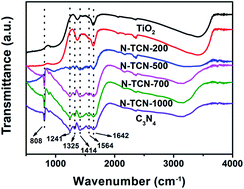In situ nitrogen-doped hollow-TiO2/g-C3N4 composite photocatalysts with efficient charge separation boosting water reduction under visible light†
Abstract
Visible-light-driven water splitting process is highly attractive for alternative energy utilization, while developing efficient, earth-abundant, and environmentally friendly photocatalysts for hydrogen evolution reaction has remained a major challenge. Herein, heterostructured photocatalysts composed of hollow N-doped TiO2 and g-C3N4 (N-TiO2/g-C3N4) were developed by an in situ impregnation calcination method. N-TiO2 and N-TiO2/g-C3N4 heterostructures with different ratios of N-TiO2 and g-C3N4 were synthesized by simply varying the amount of cyanamide (CY) as the g-C3N4 precursor. Using N-TiO2/g-C3N4 as a H2 evolution photocatalyst, the largest rate of 296.4 μmol g−1 h−1 was obtained under visible light irradiation (λ ≥ 420 nm) without any noble metal co-catalyst, which is 25.8 times larger than that of pure g-C3N4 (11.5 μmol g−1 h−1). Femtosecond time-resolved diffuse reflectance spectroscopy was used to evaluate the lifetime of photogenerated electrons and electron transfer dynamics in N-TiO2/g-C3N4. It is suggested that an additional decay pathway exists for the photogenerated electrons in N-TiO2/g-C3N4, in which N-TiO2 acts as an electron trapping site, leading to higher photocatalytic H2 evolution activity than pure g-C3N4. The present work not only provides a facile method for preparing doped materials and heterostructures with efficient photocatalytic activity, but also deepens the understanding of charge transfer dynamics in heterostructured photocatalysts.



 Please wait while we load your content...
Please wait while we load your content...